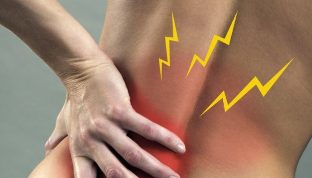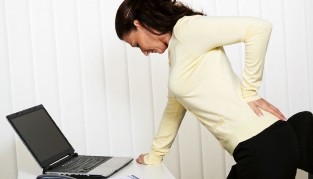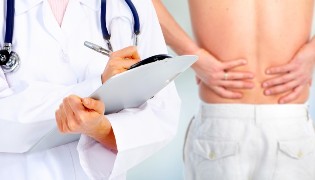The lumbar spine, in the course of life to resist a greater load. It is not surprising that, sooner or later, often at the end of the day, many are beginning to feel that they have a sore lower back. But should not be considered a normal phenomenon. Back pain have their cause, which often requires explicit treatment. And if you do not pay attention to them and do not take right steps, not knowing what to do, pain in the lower back can cause significant deterioration of your life and health.

Because it hurts the lower back — possible causes
The most likely causes of back pain lumbar, pain, lead, belly, arise from the fact that a person who spends a lot of time behind the wheel, the computer, takes care of physical work, especially if he has to drastically change the position of the body. The lower back pain lumbar may lead and the excessive load in the gym, mania jobs in the countryside, especially if you have excess weight. Are at risk, and have recently given life to a woman or those that have already entered the period of menopause
If the back pain in the lower back, one can speak of the presence of malignant and benign formations in the pelvic organs or in the pelvic cavity, diseases of the prostate or chronic prostatitis. Back pain after a long walk usually indicate the development of stenosis in the vertebral canal. A further symptom serving to the syndrome, spinal or pseudo-intermittendi lameness.
Polymyalgia rheumatica — a quite normal disease of old age. First-person feels pain in lumbo-sacral, little by little, they are amplified in the proximal upper or lower extremities appears to be stiffness and limitation of mobility.
The most common cause of pain in the lumbar-sacral it turns out low back pain. During the examination of the spine may also be detected such degenerative diseases as osteoporosis, arthritis and osteoarthritis. The distance between the vertebrate disks gradually reduced, and this violates the mechanical equilibrium of the spinal column. This, in turn, leads to the fact that the back pain the lumbar. Finally, the type of pain can be the result of muscle spasm during the execution of a unusual physical activity.
If it hurts the bottom back-to-back — the pain and the possible symptoms
The pain in the lumbar-sacral completely depends on its causes. If it is traction, the pain to apply, especially to the lumbar spine. In some cases, the damage in the buttocks and back of thighs. Mobility and twists the body is significantly limited. When jamming of the nerve roots of the lower back pain lumbar gradually down into the foot. If the cause of low-back pain is one of the systemic diseases, for example, the sciatica, the symptoms progress gradually.
Expresso the nerve endings of the spinal cord, hernia of intervertebral disk, usually found in men over the age. Usually the pain in this case are amplified when you sneeze, you cough, the laughter, the slopes, extension of the spine in the department of the lower back. Try to lie on your back and lift your leg vertical. In the presence of hernia of the intervertebral disc you are sure to feel the pain in lumbo-sacral. This type of pain is called lumbago. In the standing position is improved, and the prone position — attenuates.

If it hurts the bottom back — the secondary causes
- disease cancer spine and spinal cord;
- vertebral fractures;
- infectious diseases, which may be the defeat of the intervertebral discs and the vertebrae;
- metabolic lesions of bone tissue
- non-communicable diseases inflammatory in nature
- sharp violation of the spinal circulation, stroke;
- gastro-intestinal tract (ileus, neuroleptic atypical acute appendicitis);
- reflections of pain, which can occur in various diseases of the pelvic organs (infectious gynecological diseases, renal colic).
What happens if you have a sore lower back
Diseases that can cause lower back pain the lumbar quite a lot and almost all of them have similar symptoms. That's why it often occurs the need of differential diagnosis with the use of hardware and laboratory methods. Depending on the results of these studies and will be given the treatment of pain, and, more precisely, of those diseases that cause their appearance.
Because the back pain in the lower part of the vertebral column?
Perhaps there is no one who at least once has not dealt with the back pain. This problem is most relevant for people after the age of 60, but young occur in similar situations. It is known that the limitation of the physical activity of working age and more often because of low-back pain. Why is this happening and what should I do if it is displayed, the doctor says. And the patient needs only to come to the advice of a specialist.
All pain is a signal of certain problems in the body. And its location, it usually indicates the source of the problem. If it bothers your back, most people reasonably think of pathology of the vertebral column. True, damage to the axial skeleton represents the most frequent cause of pain in the lumbo-sacral. These states must include the following:
- Low back pain.
- Spondiloartrosi.
- Intervertebral hernia.
- An accident.
- Spondylosis.
- Ankylosing Spondylitis (As).
- Spondylolisthesis.
- Osteoporosis.
- Stenosis of the spinal canal.
- The tumors.
If this can be affected by any of the structures of the axial skeleton: the vertebrae, discs, joints, ligaments, tendons, and muscles. And a pathological process often has degenerative-dystrophic, inflammatory, or traumatic character. Contributing to this lack of physical activity, sedentary work, transport of heavy loads and other types of load on the spine. An important role play and internal factors related exchange-metabolic, immune, and the advancing age in the body.
But the back pain is a symptom not only of diseases of the spinal column. And I know all the doctors. Under this symptom may masquerade as quite common diseases of the internal organs of women and men. Therefore, the causes of pain should try between states:

- Gynecological problems.
- Diseases of the kidneys and bladder.
- Pathology of urological.
- The inflammatory bowel disease.
Also, the back hurts during pregnancy, when increases the load on the lower back due to the displacement of the center of gravity of the body and stretch the internal ligaments of the pelvic.
Because the pain appeared in the lower back, it is possible to know after the visit and further diagnosis.
When a patient turns to a doctor who wants to obtain complete information on the source of discomfort and of a further tactic. And for this you need to pass an exam. And the primary phase becomes the clinical examination, during which clarified the subjective and objective signs of pathology.
If you are talking about complaints, the biggest concern that patients call the pain. They may have different coloring, but more often characterized by the following features:
- Acute or chronic disturbances.
- Shooting, aching, pulsating, pulling, stitching.
- Of different intensity: from moderate to strong.
- They are located in the lumbo-sacral.
- Give the lower limbs, the groin area, the belly.
- Are enriched with the movements of the bust, seated, walking.
However, the back pain is not the only sign of disease – the clinical picture includes and other symptoms, for which we can assume a likely source of problems.
Diseases of the spine
When patients worried about back pain in the lumbo-sacral, it is necessary to seek confirmation vertebrogenic nature of these feelings. The pain is often associated with muscular tension or compression of the nerve roots. Therefore, they can have the following description:
- Low back pain acute back pain lumbar.
- Low back pain – stupid and deep pain.
- Sciatica – pain along the lower part of the limb in the movement of the sciatic nerve.
Sometimes the first to appear unpleasant sensation of the foot and the back starts to bother a little later. But the pain, the composition create syndrome (radiculopathy) include the characteristic neurological disorders associated with damage to sensory, motor, and vegetative fibres. He relates:
- The oppression reflexes of tendons.
- Reduction of strength in the lower limbs.
- Reduction of the sensitivity.
- Numbness, tingling or "chills, chills, a burning sensation.
- Change of color of the skin.
These violations appear in the respective dermatomes – segments of the body, which innervate the direction of the back. And local signs of pathology of the spine include muscle tension and pain paravertebral points in the lumbosacral department, the smoothness of the physiological lordosis, and limitation of active movements.
Vertebrogenic disease often occur in men and women, with age, are only progressing and can often lead to a decrease in the functionality of a person.
Gynaecological problems
If you have pain in the lumbar-sacral for women, then you need to pay attention to the possibility of pathology in the field of gynecologic. This is often inflammatory diseases or dysfunctional states. In such cases, there may appear the following symptoms:
- The irregularity of the menstrual cycle.
- Vaginal discharge.
- The increase of the temperature.
Sharp processes in the uterus and appendages can go into the chronic form, or finish a complication in the form of peritonitis. In addition, the cause of the pain can become an ectopic pregnancy or miscarriage. Then it is the risk of internal bleeding and shock.
Diseases of the kidneys and bladder
The lower back pain are considered to be one of the signs of kidney disease – jade. As a general rule, have permanent character, and in the case of kidney stones can be aggravated if rough driving or operation. Cystitis these sensations are localized in the area of suprapubic and may radiate to the sacred. The inflammatory process is accompanied by other symptoms:
- Dysuria disorders: cramping, burning sensation during urination.
- The change in color of urine.
- Fever, general malaise.
Chronic disease is accompanied by a gradual decrease of the functional capacity of the organ, which develops in renal failure.

Pathology of urological
If the men of back pain in the lower part of the back from the bottom, the differential diagnosis must be made, and with urological diseases and conditions. First of all, to exclude diseases of the prostate, prostatitis and adenoma. The pains are felt in the pubic region and the perineum, damage in the rectum and the sacrum. You will often observe additional characteristics:
- Secretion in the urethra.
- Difficulty urinating.
- The power reduction.
Acute prostatitis are possible common manifestations such as fever, weakness, malaise. And chronic inflammatory processes are lazy in nature and few symptoms.
The bowel disease
By examining the question of the origin of pain in the lumbar-sacral area, it is necessary to mention the pathology departments of the intestine. Appendicitis, ulcerative colitis, proctitis – state, which require different approaches in the diagnosis and treatment, but may be accompanied by symptoms similar. They should include:
- Sore belly, or hips.
- Change of the chair – constipation or diarrhea.
- Fever.
Colitis often found in pathological impurities in the stool, blood, mucus or pus. And objective control through the palpation of the abdomen and rectal, the research provides more information about the disease.
Nonvertebral pathology is quite different, so a doctor is necessary to clearly differential diagnosis of pain in the back.
Diagnostics
To understand why the patient hurts the lower back, you need to pass an additional examination. The doctor will prescribe a complex of laboratory and instrumental methods, the results of which will help to make the right conclusion. To him we refer such studies:
- Common blood tests and urinalysis.
- Blood biochemistry (markers of inflammation and rheumatology tests, urea, creatinine, etc.).
- Analysis of the urine for Nechiporenko, Zimnitsky.
- Analysis of genital secretions, cala.
- X-ray of the spine.
- Magnetic resonance imaging and computerized tomography.
- ULTRASOUND of the internal organs.
- Endoscopy of the intestine.
If necessary, the list of diagnostic procedures in the expansion. We used up all the possibilities to determine the source of the pain.
Treat vertebrogenic disease is necessary based on the nature of the pathological process and the individual characteristics of the patient. Is taken into consideration and the possibility of comorbidities that require appropriate correction. If the cause of the pain, not connected with the spine removed, the treatment focuses on vertebrologist, neurologists or orthopedic-traumatologo.

























